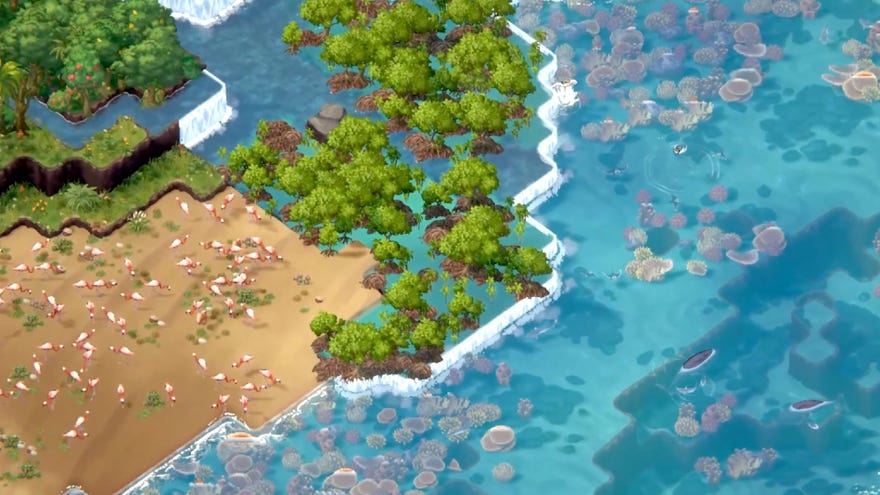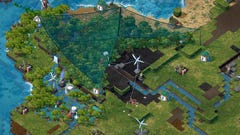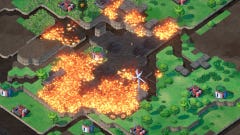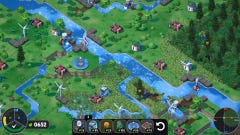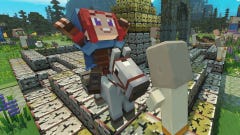Terra Nil review: a pretty reverse citybuilder that struggles to find its identity
Muddy waters
Terra Nil is a puzzle-citybuilder about reclaiming the environment. You replace pollution with lush life across a series of four randomly generated dioramas (plus four slightly more complicated challenge levels), covering the landscape in fynbos and forests, lichen and lagoons. When it all comes together and you can look over the fruits of your labour, birds chirping and piano melodically playing in the background, it’s beautiful. Getting to that point, though, is an often repetitive experience marred with frustration.
Regardless of which level you start with in Terra Nil, it plops you onto a desolate wasteland that’s yours to save. A handbook, which you can whip out at any time, breaks down each level into three stages. Your progress for the current stage is indicated with a couple of percentage meters in the top-left corner, and completing all three means mission accomplished.
The first stage always involves painting that beige box with some vivid verde. You do so using buildings that appear in a row along the bottom of the screen. These differ slightly depending on the map - the first has Turbines to provide power, while a later snowy map has Geothermal Plants, for example - but you go through more or less exactly the same motions per map. You whack down some power resources, cover the land in Toxic Scrubbers to remove the pollution they produce, and then chuck down some Irrigators to grow grass. That creates a flurry of leaves that zip towards your percentage meter, and when that reaches 100%, you’re onto the next step. It's a chill setup stage, but one that never really changes as you progress through the four main levels.
In stage two, the goal is to increase biodiversity, and you get another batch of buildings to help grow different types of plants. Some are simple. Whack beehives on trees to make fynbos, or chuck Hydroponiums on top of Irrigators to create wetland. Do enough to fill the percentage bar, and your job's a good'un. Others are slightly more complicated. To make forests, for example, you might need to first burn some of those fynbos with a Solar Amplifier, before scattering Arboretums across the ash piles that are left behind. On a later level, you use Igneous Heatsinks to cool lava and form rock, on which you can then grow lichens using an Algae Greenhouse. You can also send these greenhouses along a monorail and chuck them in the ocean to grow kelp underwater, killing two birds with one stone.

The processes are indeed different, but in the same way that a digestive and a rich tea biscuit are different. One's better for dunking, you might scream, and one has slightly more crunch. But, regardless of which biscuit you bought in your weekly shop, you’ll still devour them in two seconds, and they'll both still taste like cardboard (ed: an outrageous slander, Hayden). If both are in the biscuit tin, there’s no pondering which you’d prefer, because they offer an almost identical experience. In the same way, using Arboretums to create forests or Algae Greenhouses to cover rocks with lichens feel one and the same in Terra Nil. Sure, they have different names and appearances, but it all feels like I'm just chasing numbers.
I select the building, plonk it somewhere that the map tells me is suitable, and watch the percentage bar in the corner tick slightly higher. Sometimes I found myself stumped for a second because of specific requirements, such as needing to have an Irrigator on high ground instead of low, but this can be corrected in about the time it takes to grab another rich tea biscuit with your spare hand.
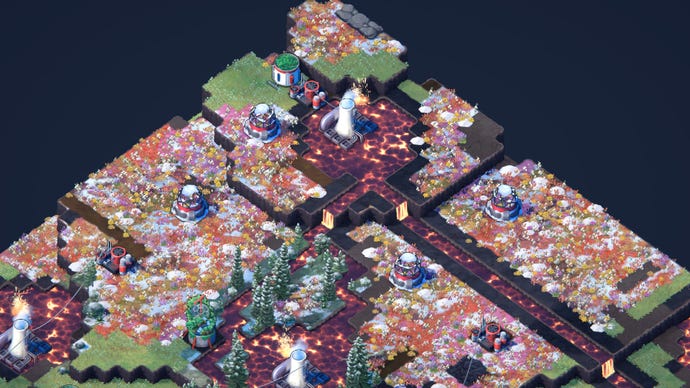
Admittedly, there is a small bit of resource management in this second stage that helps liven things up a touch. All buildings cost leaves, which is the generic resource you gather while spreading greenery. If you get carried away plopping down buildings to increase biodiversity, it's easy to forget that you're pulling from a limited pool of supplies. If your resources drop to zero, you'll need to start again. However, this resource management rarely felt like something I had to actively engage with, even on the highest difficulty. I found the answer to simply be efficiency, using as few buildings as possible to achieve my goal. At some point during this second stage, you'll start to gather an abundance of resources, and from there you'll quickly snowball into a victory. After settling on this approach in the first level, Terra Nil never prompted me to reevaluate my methods when faced with new levels or environments.
The third and final step is where Terra Nil reveals its "reverse-citybuilder" wildcard, as it tasks you with cleaning up any buildings you placed down earlier with recycling stations and drones. Only then can you jet off and claim victory. It’s an important message - what you leave behind has consequences, so you must remove any trace that you were here - but the stage itself feels more like an unavoidable punishment. While you can minimise this section by grouping buildings close together in the prior stages, I found it to be a tedious chore, regardless of length. That's partly because, in practice, it still boils down to the same percentage filling exercise as previous stages. You spend resources (of which you'll likely now have a ridiculously big supply of) to place down recycling silos and nodes, which then make that recycling meter tick closer to 100%. The only difference is that it's now stretched out depending on how disorganised you were earlier in the level.

Terra Nil is, at the very least, peaceful for its first three stages. Calming music plays, rivers flow, vivid colours replace dreary wasteland. It’s all very nice to watch come alive, and if served as the side dish alongside your podcast main meal, I’m sure it’d be fitting. Indeed, I could probably see myself clicking through its puzzles with my eyes firmly glued to a second screen to watch Critical Role or Dimension 20.
Until, that is, you get to the fourth level. This is a drowned city with derelict buildings scattered about beneath the water, a stark contrast to the purely natural environments that came before it. Cracking on as I did previously, I started dredging water before placing some power sources and spreading those Toxin Scrubbers. The first stage passed calmly, just like the last three levels. Then, as I entered the second stage, sirens sounded and waste bunkers burst open, covering the land in radioactive gas. Here, Terra Nil took a turn from a calming puzzler that lingers on a hopeful message of reclaiming the environment to one that directs your attention to the horrors destroying it. While undoubtedly an important and stark symbol, it seems the antithesis of the identity Terra Nil has spent the past few hours building. Radiation spreads, and, despite the music resuming its previously peaceful melody, the calm is gone.
There are also a few bugs that cropped up in this level, shattering any final strands of relaxation. Undersea Dredgers sometimes wouldn't work, forcing me to restart the level repeatedly until they finally got their act together. A few times, I'd start a level only to find that I was stuck on the closest zoom level, unable to pull away to my usual bird's eye view. I also had one instance of the final level in which it wouldn't allow me to place Bamboo Nurseries within some of the skyscraper frames, preventing me from reaching my biodiversity goal despite having cleared all radiation.

By the time I launched my final rocket from Terra Nil, I was happy to leave it behind. It certainly feels refreshing in the citybuilding genre, which is so often focused on creating infinite growth and bustling metropolises, nature be damned, but ultimately, it's still a game about chasing numbers, and filling meters that allow you to progress. That alone could be comforting, some much needed calm in a busy world as you create a lush landscape, but I found its repetitive nature was more frustrating than relaxing. Topped off with a level that shifts the focus from its previously hopeful tone to one of somber silence as you suck away the radiation, Terra Nil struggles to cement its identity as the calm, meditative puzzler that it seems on the surface.
